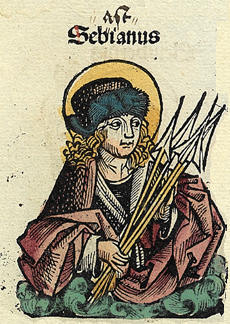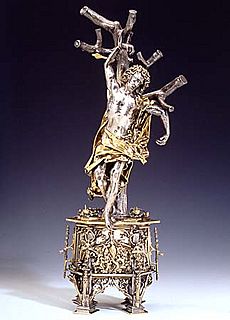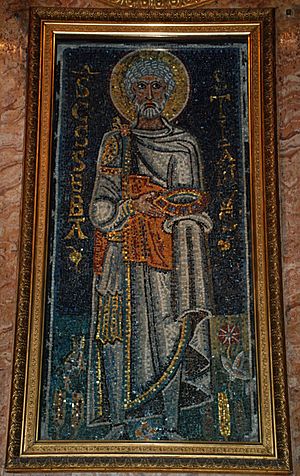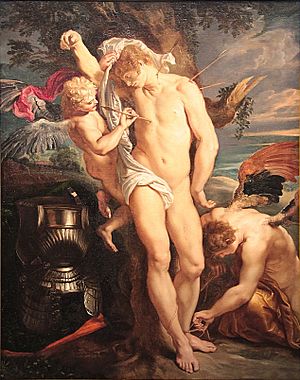Saint Sebastian facts for kids
Quick facts for kids SaintSebastian |
|
|---|---|
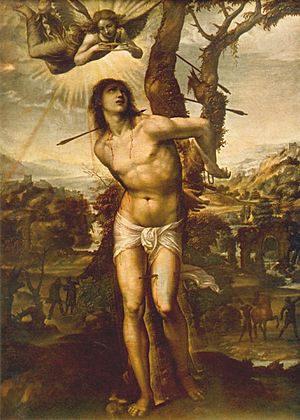
Martyrdom of Saint Sebastian, by Il Sodoma, c. 1525
|
|
| Captain of the Praetorian Guard Roman Soldier, Healer and Martyr |
|
| Born | c. AD 255 Narbo Martius, Gallia Narbonensis, Roman Empire |
| Died | c. AD 288 (aged approximately 32) Rome, Italia, Roman Empire |
| Venerated in | Catholic Church Orthodox Church Oriental Orthodoxy Anglicanism Aglipayan Church |
| Major shrine | San Sebastiano fuori le mura Italy |
| Feast | 20 January (Roman Catholic), and (Oriental Orthodox) 18 December (Eastern Orthodox) |
| Attributes | Tied to a post, pillar or a tree, shot by arrows |
| Patronage | Soldiers; plague-stricken; archers; disabled peoples; athletes; cyclists; Negombo, Sri Lanka; Archdiocese of Lipa; Diocese of Tarlac; Diocese of Bacolod;Chiapa de Corzo, Mexico; Rio de Janeiro, Brazil; Lumban, Laguna, Philippines; Borbon, Cebu, Philippines; Pucallpa, Peru; Taquaritinga, Brazil; Ribeirão Preto, Brazil; Győr, Hungary; Cusco, Peru; Loja, Ecuador; Rome, Italy |
Saint Sebastian was an early Christian saint and martyr. A martyr is someone who dies for their beliefs. He lived in the Roman Empire around 255 AD and died in Rome around 288 AD.
According to old stories, Sebastian was killed during a time when Christians were persecuted. This means they were treated badly and even killed for their faith. He was first tied to a post and shot with many arrows. But this did not kill him!
He was then rescued and healed by a kind woman named Saint Irene of Rome. After he recovered, Sebastian bravely went to the Roman Emperor Diocletian. He wanted to warn the emperor about his cruel actions against Christians. Because of this, Sebastian was beaten to death.
Today, Saint Sebastian is honored in the Catholic Church and the Orthodox Church. He is seen as a protector and a symbol of strength.
Contents
Who Was Saint Sebastian?
The oldest records that mention Saint Sebastian are from the year 354 AD. They say he was a martyr and was honored on January 20. Another important mention comes from a bishop named Ambrose of Milan in the late 300s. Ambrose said that Sebastian was from Milan and was already a respected saint there.
The full story of Sebastian's life and death comes from a text written in the 400s. This text tells about his two times facing death and how Saint Irene helped him.
Sebastian was born in Gallia Narbonensis, which is now part of France. He was educated in Milan, Italy. Around 283 AD, he joined the Roman army in Rome. He wanted to help Christians who were being persecuted.
Sebastian was very brave and became a captain in the Praetorian Guard. This was a special group of soldiers who protected the Roman emperors. Emperors Diocletian and Maximian did not know that Sebastian was a Christian.
Helping Other Christians
Sebastian secretly helped many Christians. He even helped two brothers, Marcus and Marcellianus, who were deacons. Deacons are church helpers. These brothers were arrested for being Christian.
Sebastian managed to convince their parents, Tranquillinus and Martia, to become Christians. He also converted other officials and their families. One woman, Zoe, had not been able to speak for six years. When she became a Christian, her speech returned!
After these conversions, a Roman official named Chromatius set all his Christian prisoners free. He then left his job and moved to the countryside. Sadly, Marcus and Marcellianus were later killed for their faith, as were Nicostratus, Zoe, and Tiburtius.
Sebastian's Brave Stand
Sebastian kept his faith a secret for a while. But in 286 AD, Emperor Diocletian found out. The emperor was very angry. He ordered Sebastian to be tied to a stake in a field. Then, archers were told to shoot arrows at him.
The archers shot so many arrows that Sebastian looked like a hedgehog. They left him there, thinking he was dead. But a miracle happened: the arrows did not kill him!
A kind widow named Irene of Rome went to get his body to bury it. She found that he was still alive. She took him to her house and nursed him back to health.
After he recovered, Sebastian did something incredibly brave. He stood by a staircase where the emperor was going to pass. He spoke loudly to Diocletian, criticizing his cruelty towards Christians. The emperor was shocked to see Sebastian, whom he thought was dead.
Diocletian quickly ordered Sebastian to be captured again. This time, he was beaten to death with clubs. His body was then thrown into a sewer. However, a holy lady named Lucina was told in a vision to rescue his body. She secretly took it and buried it in the catacombs. These are underground tunnels used for burials. Today, the Basilica of St. Sebastian stands where he was buried.
Where Are His Remains?
Parts of Saint Sebastian's remains are kept in Rome. They are in the Basilica Apostolorum, which was built in 367 AD. This church is now called San Sebastiano fuori le mura.
In 826 AD, some of Sebastian's remains were given to an abbot named Hilduin. He took them to France, where they were placed in the Saint Medard Abbey.
Sebastian's skull was brought to a town called Ebersberg in Germany in 934 AD. A monastery was built there, and it became a very important place for pilgrims. People say the silver-covered skull was used as a cup during special church services.
- Reliquary of Saint Sebastian in Ebersberg
Saint Sebastian and the Plague
During the Middle Ages, people believed that Saint Sebastian could protect them from the plague. The plague was a terrible disease that caused many deaths. This belief made him very popular, especially when the plague was spreading.
It might seem strange that a saint shot with arrows would be linked to the plague. But in ancient myths, the god Apollo could shoot arrows that brought disease. He could also stop the disease. So, Sebastian became a Christian version of this idea.
Also, Sebastian survived being shot with arrows. This gave people hope that they could also recover from the plague. The arrow wounds on his body were also thought to look like the painful swellings caused by the bubonic plague.
One story says that in 680 AD, Rome was saved from a terrible plague by Saint Sebastian. Another story from the Golden Legend tells how a great plague in Italy stopped after an altar was built to honor Sebastian.
Sebastian in Art and Stories
Artistic Depictions
The earliest known picture of Sebastian is a mosaic in Italy from between 527 and 565 AD. It shows him as part of a group of martyrs. Another early mosaic from 682 AD shows him as an older, bearded man, but without arrows.
The images of Sebastian with arrows began to appear around the year 1000. Since then, artists have shown him being shot with arrows much more often than being beaten to death. This is why many people mistakenly think he died from the arrows.
Because he was seen as a protector against the plague and a saint for soldiers, Sebastian became very important in the Middle Ages. Many famous artists painted him, especially after the Black Death. Artists like Botticelli, Perugino, Titian, Mantegna, and Guido Reni all created famous paintings of Saint Sebastian.
He is usually shown as a handsome young man with arrows piercing his body. Sometimes, paintings also show his arrest, his talk with the emperor, and his final death. The picture in the infobox is a famous painting by Il Sodoma.
Stories, Films, and Music
Saint Sebastian has inspired many works of art, literature, and music.
- In 1911, a play called Le Martyre de saint Sébastien was created.
- The American composer Gian Carlo Menotti wrote music for a ballet about him in 1944.
- In the book Death in Venice, Saint Sebastian is seen as a symbol of beauty and strength in suffering.
- His death was shown in the 1949 film Fabiola.
- Famous boxer Mohammad Ali was pictured like Saint Sebastian on the cover of Esquire Magazine in 1968.
- A fresco of Saint Sebastian is a key part of the 1976 horror film The House with Laughing Windows.
- The TV show Millennium had an episode where characters searched for the hand of Saint Sebastian.
- Artist Damien Hirst created a modern art piece in 2007 showing a cow shot with arrows, titled "Saint Sebastian, Exquisite Pain."
- The music video for the song "Hunger of the Pine" by Alt-J shows references to Sebastian's story.
- The music video for R.E.M.'s "Losing My Religion" also uses images inspired by paintings of Saint Sebastian.
- The band The Mountain Goats has a song called "Hail, St. Sebastian."
- Madonna's song "I'm a Sinner" mentions Saint Sebastian.
- The Canadian TV series Forgive Me features a priest who sees visions of Saint Sebastian.
- The character Gemino in the video game Blasphemous is inspired by Saint Sebastian.
Patron Saint of Many
In the Roman Catholic Church, Saint Sebastian is remembered on January 20. He is also honored on December 18 in the Church of Greece.
He is known as a protector against the bubonic plague. Sebastian is also the patron saint of:
- Archers
- Pin-makers
- Athletes (a more recent connection)
- People hoping for a holy death
Many cities and places around the world have Saint Sebastian as their patron saint. These include:
- Qormi in Malta
- Acireale, Caserta, and Petilia Policastro in Italy
- Melilli in Sicily
- San Sebastián, Palma de Mallorca, Lubrín, and Huelva in Spain
- Negombo, Sri Lanka
- Rio de Janeiro, Brazil
In Lubrín, Spain, there is a special festival every year on January 20. A statue of Saint Sebastian is carried in a parade. People throw bread rolls with holes in them from their balconies to the crowds below. This festival is thought to have started in the 14th century after a cholera plague. It's a very unique festival!
King Sebastian I of Portugal was named after the saint because he was born on Saint Sebastian's feast day.
In Kerala, India, Catholic communities celebrate the Feast of St. Sebastian with lights, decorations, and fireworks. Many churches and schools in Kerala are named after him.
Saint Sebastian is also the patron saint of:
- San Sebastian College – Recoletos in Manila, Philippines
- The Roman Catholic Diocese of Bacolod in the Philippines
- Lipa City in the Philippines
- Leon City in Mexico (his image is on the city's coat of arms)
The St. Sebastian River in Florida, USA, is named after him. The nearby city of Sebastian, Florida and a state park are also named for Saint Sebastian.
See also
 In Spanish: Sebastián de Milán para niños
In Spanish: Sebastián de Milán para niños
- Le martyre de Saint Sébastien, Claude Debussy
- Saint Sebastian at the Column
- The three paintings by Mantegna
- Saint Sebastian and the Angel


